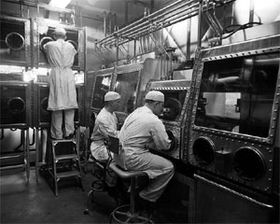
Back Biocontenció Catalan Biocontención Spanish Confinement (biologie) French Biocontenção Portuguese

One use of the concept of biocontainment is related to laboratory biosafety and pertains to microbiology laboratories in which the physical containment of pathogenic organisms or agents (bacteria, viruses, and toxins) is required, usually by isolation in environmentally and biologically secure cabinets or rooms, to prevent accidental infection of workers or release into the surrounding community during scientific research.
Another use of the term relates to facilities for the study of agricultural pathogens, where it is used similarly to the term "biosafety", relating to safety practices and procedures used to prevent unintended infection of plants or animals or the release of high-consequence pathogenic agents into the environment (air, soil, or water).